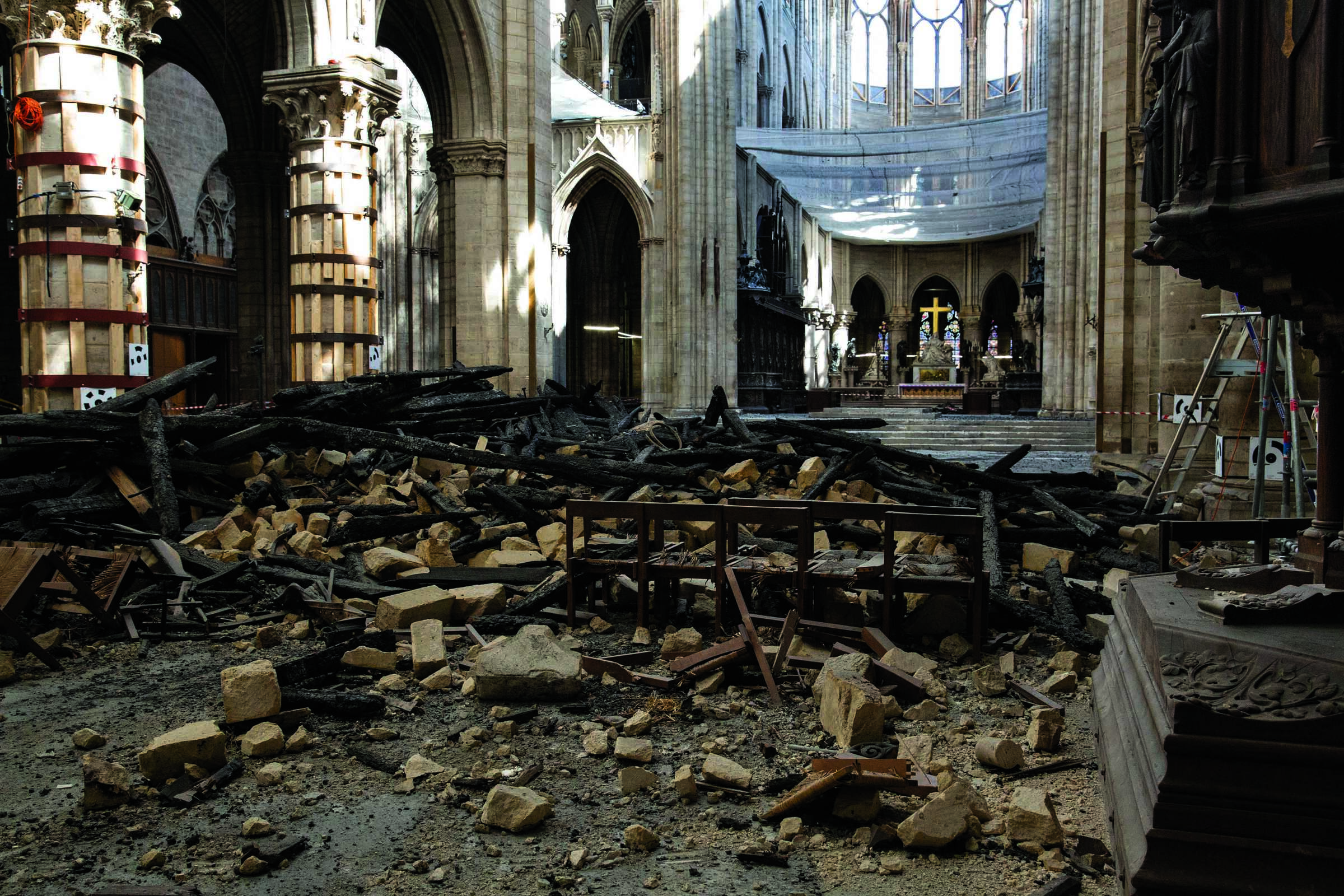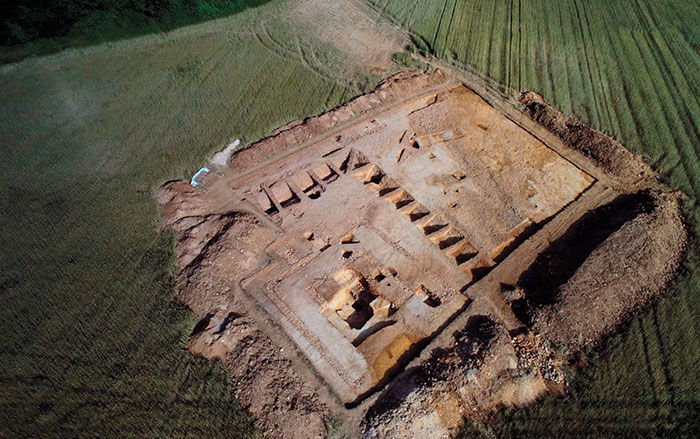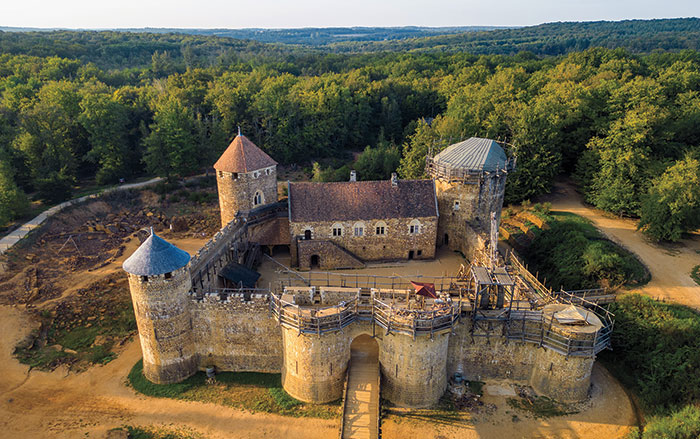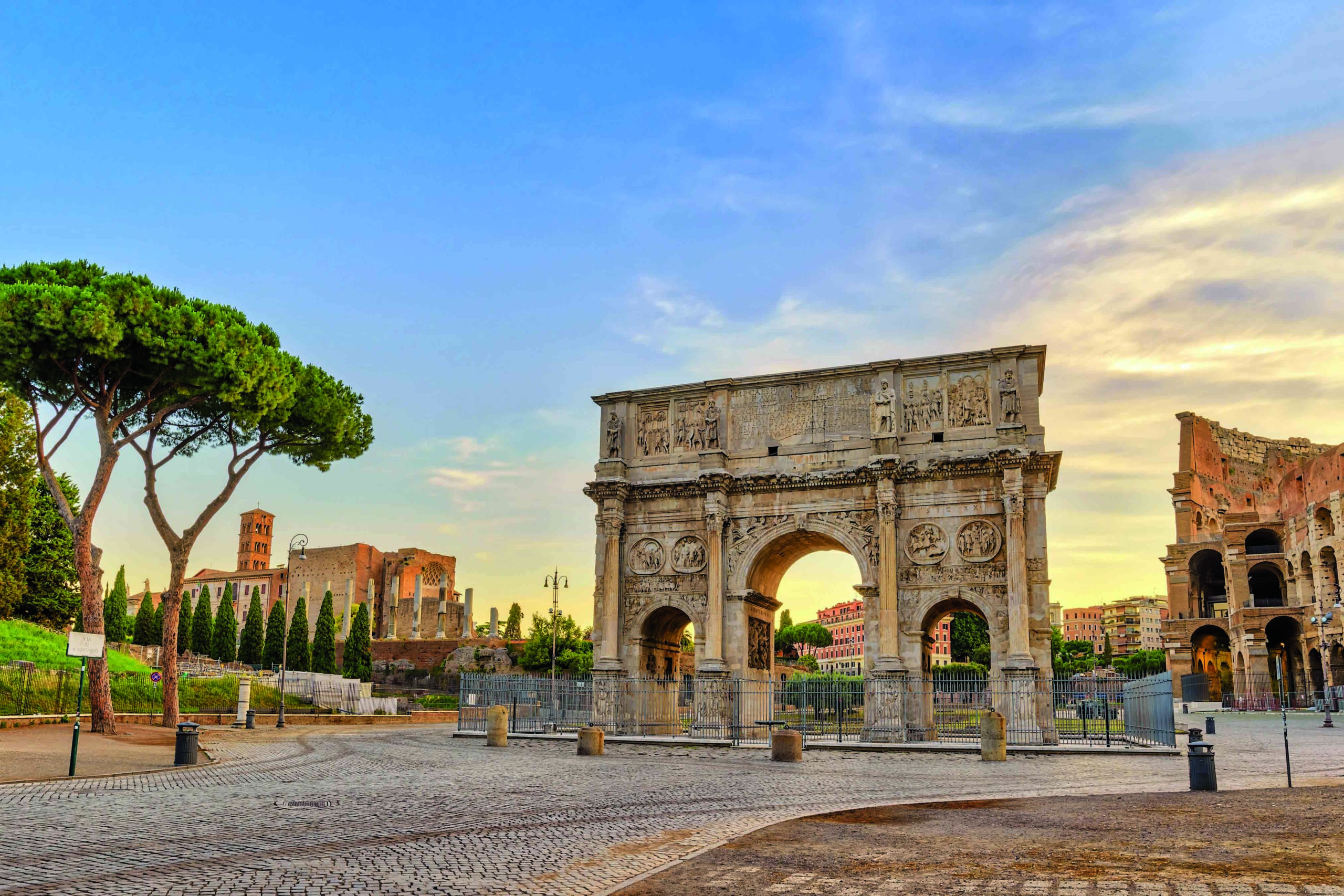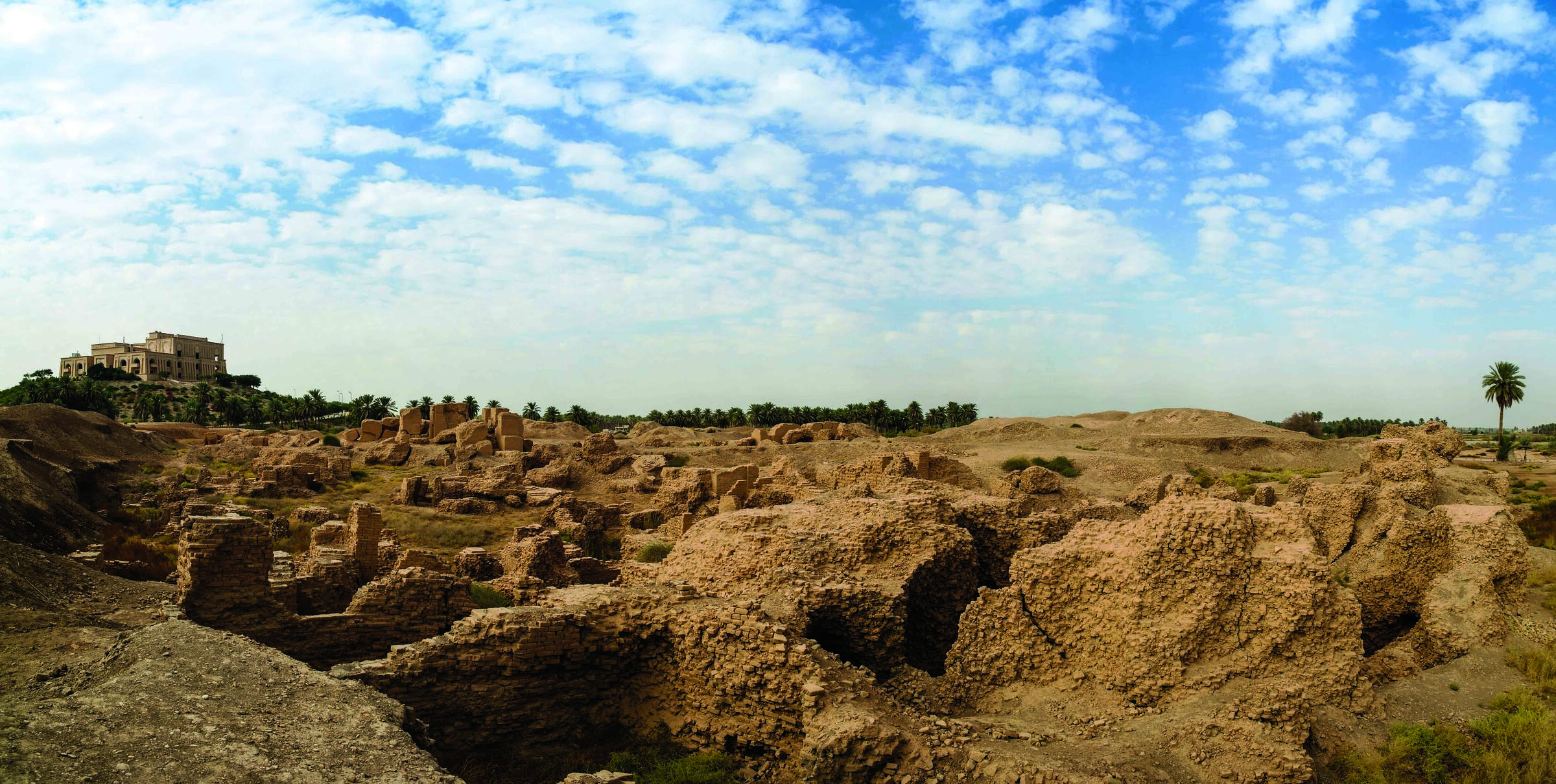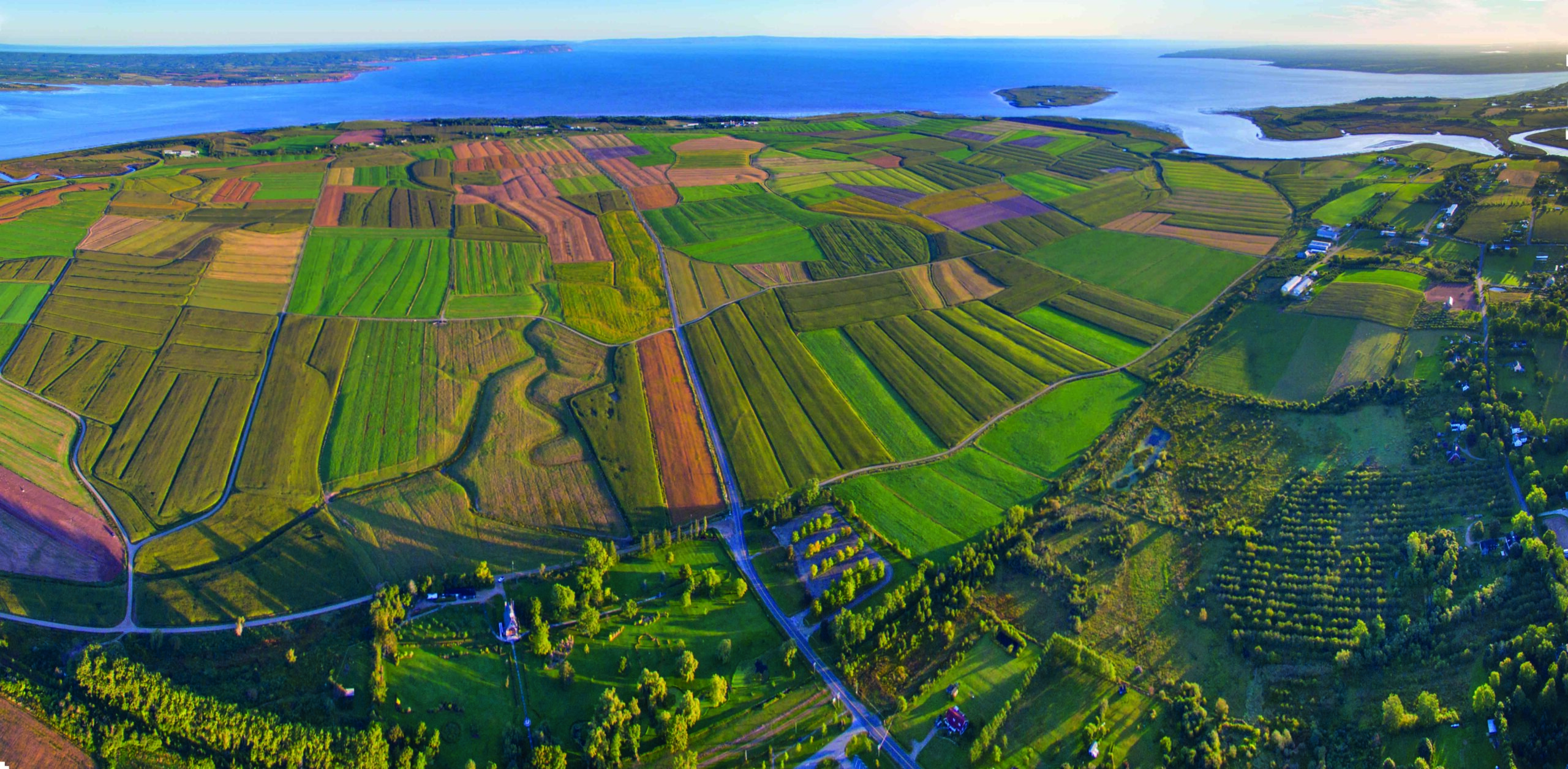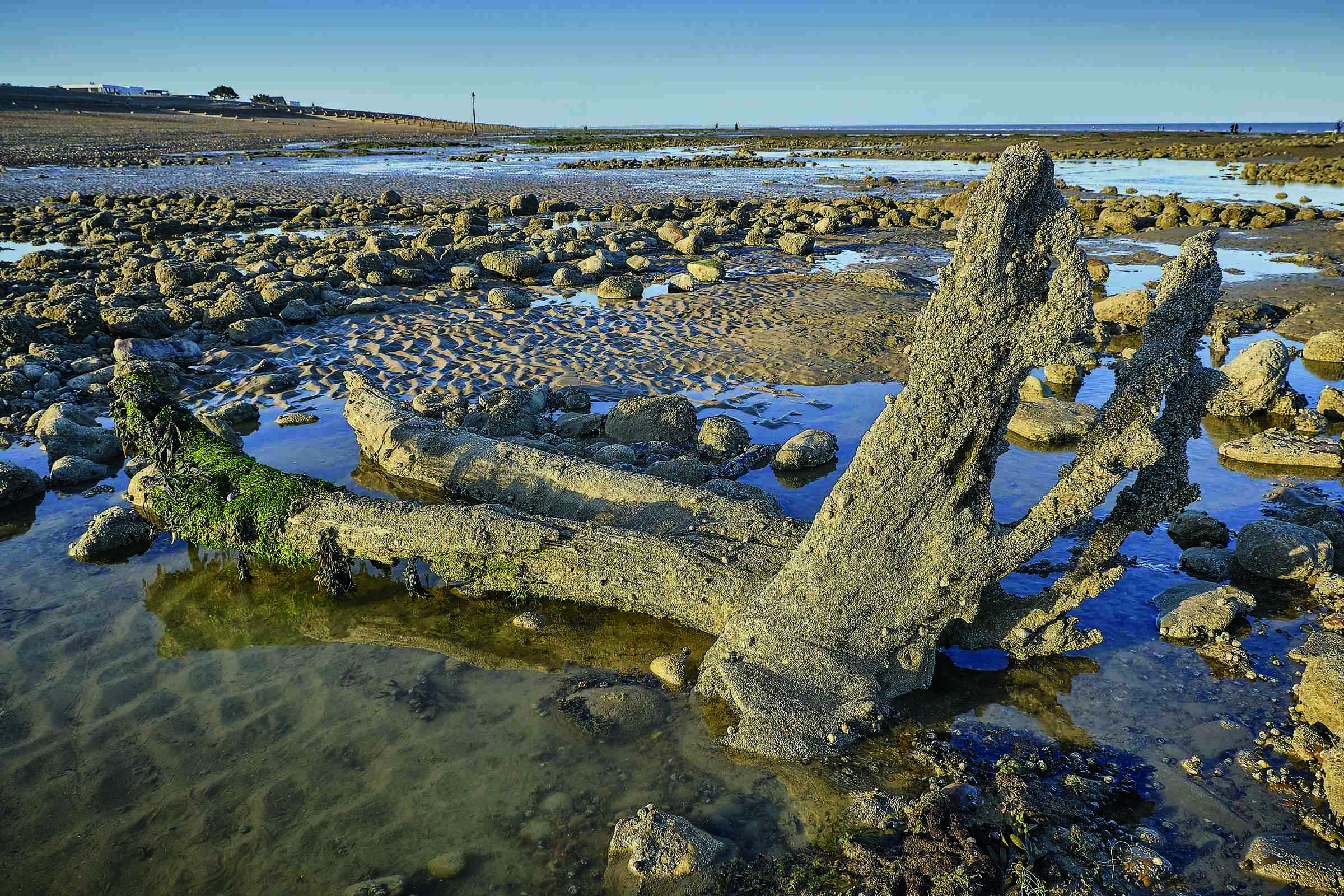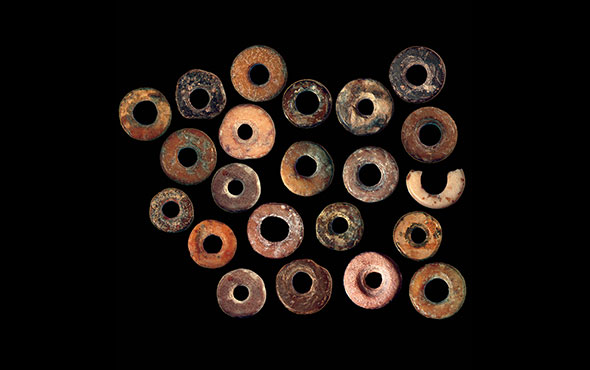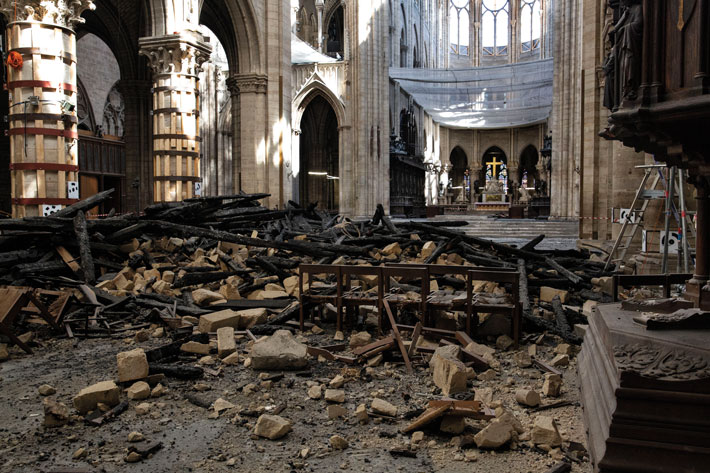
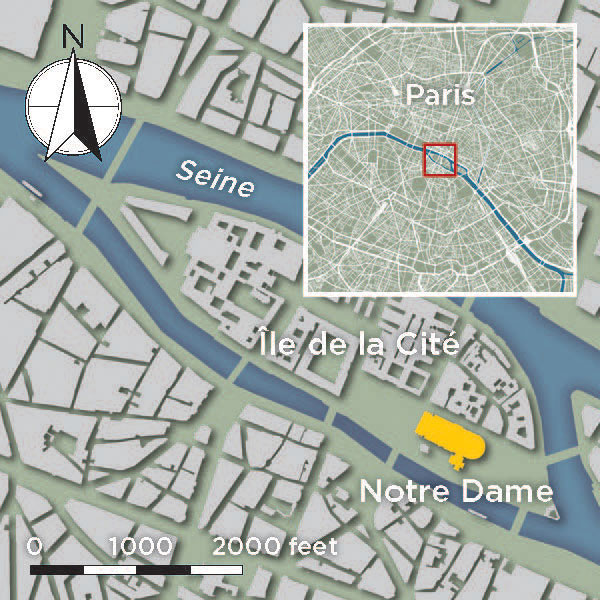
The first major fire at Paris’ Notre Dame Cathedral burned through an August night more than 800 years ago. At the time, cathedral fires were not uncommon—the structures were tinderboxes of dry wood, textiles, hanging lamps, and burning candles. The twelfth-century chronicler Guillaume le Breton records that the inferno started when a thief broke into the cathedral’s attic and, using ropes and hooks in an attempt to steal the candlesticks, set the silk hangings alight. Over the following centuries, there were almost certainly many more fires, but none as catastrophic as the one that began in the attic and engulfed the building on April 15, 2019. The cause of that conflagration remains uncertain; an electrical short circuit or damaged electrical cable in use during restoration efforts taking place at the time are the possible culprits.
For 15 hours, flames reaching nearly 1,200°F ate away at a large part of the cathedral’s medieval wooden roof, which crashed onto the stone vaulting that forms its ceiling. The nineteenth-century spire that topped the building broke apart when the lead coating meant to protect it melted. The weight of the debris caused a ceiling vault to collapse, sending huge piles of burned wood and broken stone down to the marble floor of the nave. When the fire was finally extinguished, the scene was one of complete devastation and the atmosphere one of extreme concern. Parisians, along with those watching from around the world, wondered if the building was structurally sound, if the cathedral’s spectacular stained-glass windows had survived, and if Notre Dame, which has been called the soul of the city—and of France—could ever be rebuilt.
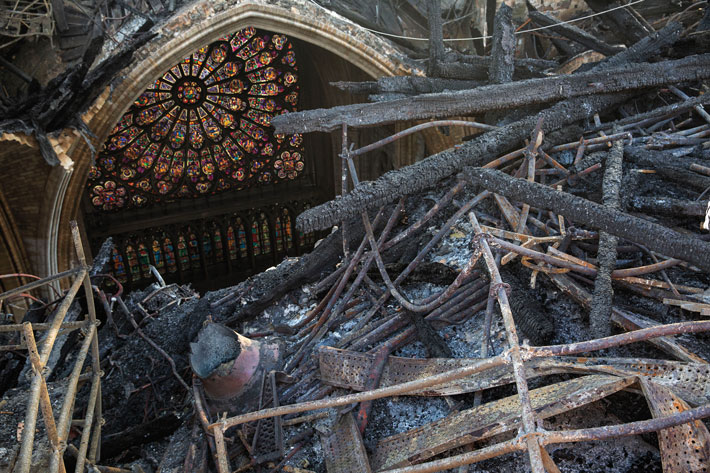
The fire pared Notre Dame to its core, but the destruction is providing an unprecedented chance for scholars to investigate its history and reimagine its future. For archaeologists, the bent iron, burned roof timbers, and shattered stonework provide an opportunity to study a building that, despite its religious, architectural, and historic significance, is, in fact, poorly understood. Over time, the cathedral was modified to accommodate the requirements of a growing staff of clergy and an expanding congregation, as well as the increasing number of visitors to a building not designed for mass tourism, obscuring its medieval origins. Since the nineteenth-century renovation by architect Eugène-Emmanuel Viollet-le-Duc, there has been little opportunity to study the cathedral’s archaeological record.
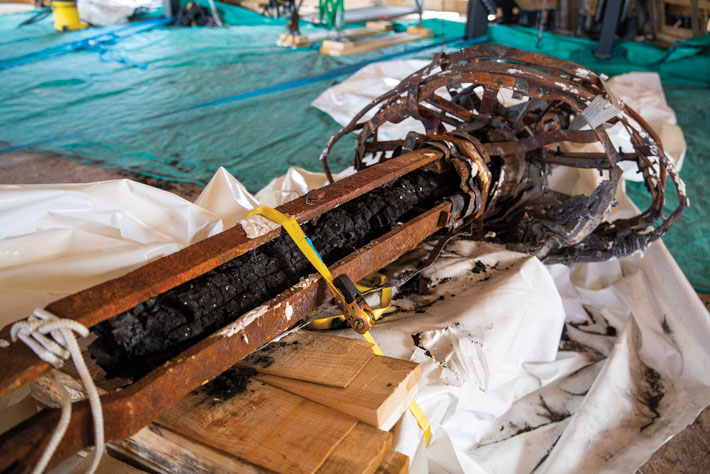
Archaeologists and other specialists removed, sorted, and inventoried the collapsed remains from late April 2019 to spring 2021, after which the artifacts were transferred to rented warehouses in the northeast of Paris where they are available for study. What researchers have collected is considerable—about 10,000 pieces of wood, 650 pallets of stone, and 350 pallets of metal. “It’s impressive to have Notre Dame right there in front of us,” says archaeologist Dorothée Chaoui-Derieux of the French Ministry of Culture. “There is a certain emotion to have at hand blocks of stone that were previously more than 100 feet up and about which little was known, or all this wood, some of which dates to the thirteenth century and still smells like burning from the fire.”
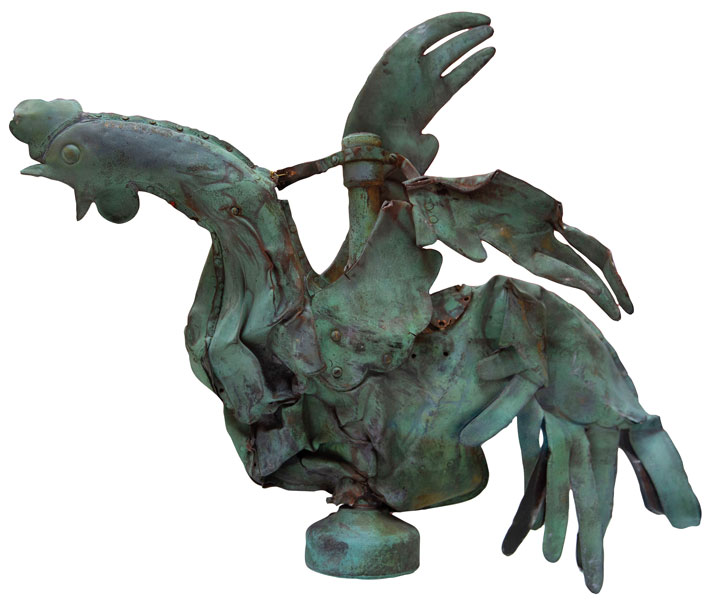
Chaoui-Derieux is chief curator of heritage at the Regional Archaeology Service based in the Île-de-France, the region including and surrounding Paris. She is part of a huge team that includes at least 100 researchers from the Ministry of Culture, the French National Center for Scientific Research, and the French National Institute of Preventive Archaeological Research (INRAP), all dedicated to studying and restoring Notre Dame. In addition to medieval archaeologists, experts in glass, metal, wood, and stone are investigating the materials Notre Dame’s builders used and discovering how their skill would safeguard the cathedral some eight centuries after it was constructed. This work will take many years, long past the planned reopening of the restored cathedral in 2024, and thus far, has raised more questions than it has answered. But the fire has led to an archaeological project like no other.
The history of the site that would eventually be home to the cathedral of Notre-Dame de Paris on the Île de la Cité, or City Island, is long and varied. Paris had its origins in the Gallo-Roman town of Lutetia, on the left bank of the Seine. It took its current name from the Parisii, a Gallic tribe that had permanently settled on the island by a.d. 25, although they may have inhabited it for centuries before as it was a convenient point at which to cross the river. The site was fortified in a.d. 308 by the province’s Roman governor, and in the early sixth century A.D., the first king of the Franks, Clovis I (r. ca. A.D. 509–511), chose Paris as his capital and built a palace on the island. Later in the sixth century, Paris’ first cathedral, the cathedral of Saint Étienne, or Stephen, the first Christian martyr, was built close to the south portal of the present-day cathedral. Many other buildings and monuments were constructed over the next few centuries, most of which were torn down during eighteenth- and nineteenth-century development of the site, which included razing buildings deemed unsanitary during an 1865 cholera epidemic.
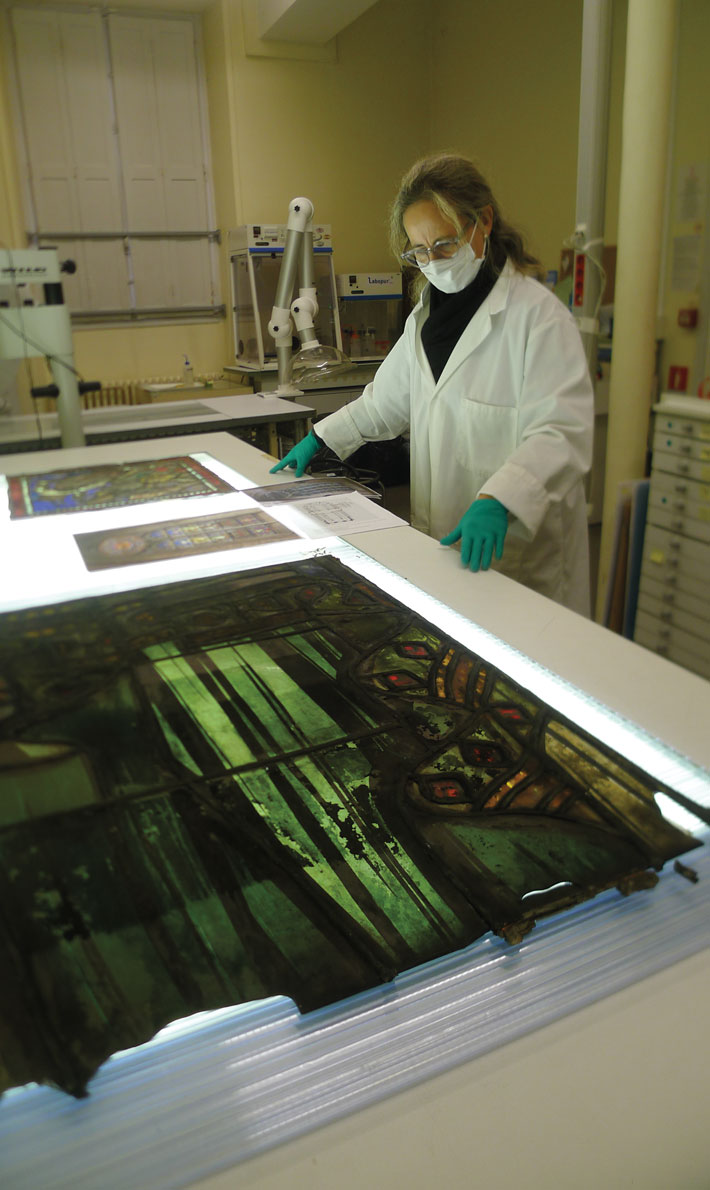
In 1163, the bishop of Paris, Maurice de Sully, began work on a new cathedral built of Lutetian limestone at the island’s eastern end on the ruins of two earlier churches, including that of Saint Étienne, and, farther down, ruins of a temple dedicated to Jupiter dating to the city’s Roman period. The current Notre Dame Cathedral measures 427 by 157 feet, soars 115 feet high, and can hold more than 6,000 people. It was mostly built by 1245, but not completed for another century.
Its role as a useful river crossing played a part in its selection for the new place of worship. At the time, many of the thousands of pilgrims who traveled each year from France to the holy site of Santiago de Compostela in Spain, as well as Crusaders who set out for Jerusalem, crossed the Seine. Many stopped on the Île de la Cité, making it an even more important religious site. It became the seat of the archbishop of Paris, which it remains today. It also became a lively commercial and residential area, home to clerics, servants, and merchants. In the thirteenth century, Notre Dame’s importance was burnished when relics from the Passion of Christ, including the crown of thorns, were brought to Paris from Jerusalem and placed in the cathedral. The building also housed a thirteenth-century tunic of Saint Louis. The crown, tunic, precious sets of candlesticks, and other relics were among the first objects saved from the 2019 fire. A copper rooster that had crowned the spire and contained relics of Saint Geneviève, the city’s patron saint, was found by a restorer sorting debris on the street.
Notre Dame is built in the Gothic style, which was widely adopted between the mid-twelfth and sixteenth centuries across Europe. The size of Romanesque-style buildings constructed prior to and in the mid-eleventh century was limited by engineering challenges that had yet to be solved. By the time Notre Dame was built, architects had begun to find solutions to these problems, and the soaring, cavernous cathedrals of medieval Europe could be constructed.
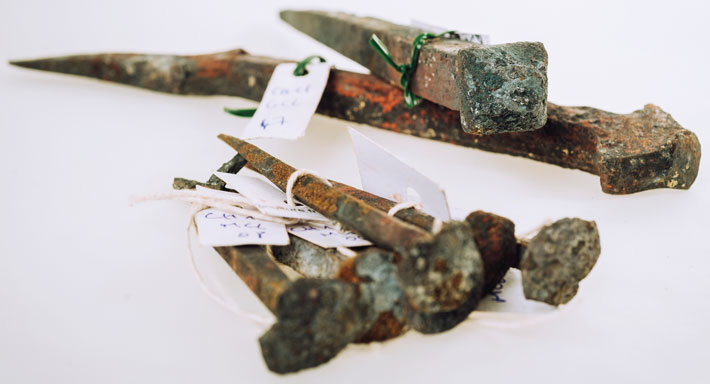
The primary innovations that allowed gigantic Gothic cathedrals to stand, even though their walls are pierced with numerous huge stained-glass windows, are rib vaults and flying buttresses. Rib vaults are much lighter than the groin or barrel vaults that hold up Romanesque cathedrals. Because they are composed of diagonal, crossing arched ribs, the building’s thrust—the outward pressure of a vault or arch—can be distributed out to the corners of the vault and down to the ground on thin columns and piers. Masonry buttresses on the cathedral’s exterior—called flying because they are high on the wall—carry the tremendous thrust of the vaults and roof, making the high ceilings of Gothic churches possible. The massive cruciform interiors of these cathedrals could then be divided into the main aisle, called the nave; the arms that cross the nave, or transept; the space between the nave and the altar, called the choir; and additional aisles and chapels.
As Notre Dame burned through the night and the sounds of raging flames, cracking stone, and falling roof beams filled the air, many lining the Seine held their breath for the sound of shattering glass that would signal the destruction of the cathedral’s stained-glass windows. They were especially concerned about the immense circular windows—called rose windows because they resemble multi-petaled flowers—that are a defining feature of Gothic architecture. Throughout the medieval period, the designs for these windows were adapted to play with light and color, creating patterns as complex as carpets.

Notre Dame’s rose windows sit over the north, south, and west portals and were completed in the early to mid-thirteenth century. They are the only windows in the cathedral to retain their original medieval glass. As daylight came up on smoldering embers, reports started to arrive from people who had trained their binoculars on the windows for hours: They were intact, thanks not least to the skills of the Parisian firefighters who had averted further disaster by aiming their hoses away from the glass as water pressure could have caused the windows to explode.
Though the rose windows were unharmed, colorful stained-glass panels by later artists that were part of Viollet-le-Duc’s restoration did sustain some damage. After the fire, a panel depicting King David was brought to the Historical Monuments Research Laboratory, 15 miles from Paris, where glass specialist Claudine Loisel examined it for evidence of cracks due to intense heat. “There is some damage, but nothing catastrophic,” she says. “Overall, the stained-glass windows are all in a good state of conservation with only a few occasional thermal breaks.”

Glass is only one of the materials used in Notre Dame that specialists are now studying. The immense amount of lead used for the cathedral’s medieval construction and nineteenth-century spire is both a curse and a blessing for modern scholars. During the fire, the heated lead emitted toxic fumes that lingered for months. But lead can also provide evidence of the provenance of materials and of the methods builders employed. Medieval archaeologist Maxime L’Héritier leads the group working on the metal from Notre Dame. Because of the poisonous emissions from the lead, he had to wait six months to access the cathedral’s interior. He was finally allowed in, wearing a protective suit and using a respirator. “I remember the shock the first time,” L’Héritier says. “We are researchers, but humans, too.”
At the time the cathedral was built, lead was commonly used for roofing in major monuments, providing sealing for stones and the staples or metal pins inside columns, and as decoration. “Lead was a prestige material and lead workers were very important in medieval times,” says L’Héritier. “Nails, staples, and iron pins can all be sealed with mortar or by pouring in molten lead which solidifies. In Notre Dame, most examples we saw, though not all, are sealed with lead.” Hundreds of lead samples have been taken for isotope analysis and other chemical experiments. Researchers will also be able to track how lead materials were reused during past renovations and which ones might be reused as part of the current reconstruction.
The cathedral’s nails, many of which were recovered from the burned remnants of its upper sections, are a significant part of the archaeological evidence. By studying the nails, researchers may be able to date some of the changes and repairs undertaken since the thirteenth century.
EXPAND
Layers of History
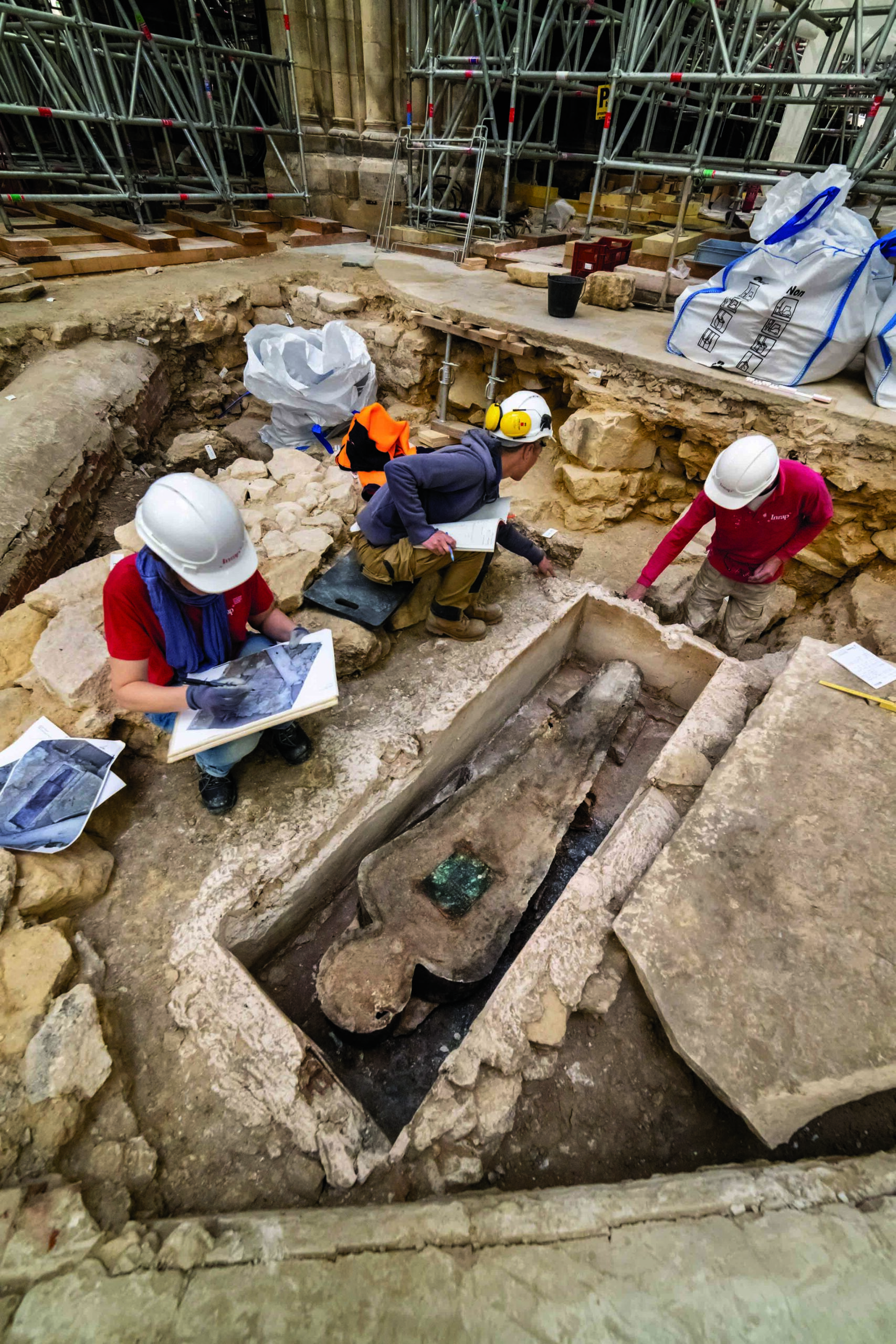
Scaffolding that had been erected for a restoration project at Notre Dame melted into the building during the April 2019 fire. Before workers removed this scaffolding, archaeologists had a unique opportunity to dig at the site. During this project, archaeologists from the French National Institute of Preventive Archaeological Research, overseen by Xavier Peixoto, dug three test pits. Two revealed little of interest, but the third brought to light a 10-foot-high medieval limestone quay wall that predates the Gothic church begun in 1163 and provides new evidence of the earlier history of the site.

The wall had first been discovered in 1918, at which time the lower part was dated to the pre-Roman Gallic period and the upper part to the Roman era. But according to Peixoto, the entire wall is medieval and dates to the end of the eleventh or first half of the twelfth century. “It’s an important find because it’s earlier than the cathedral and the episcopal palace of its builder, Maurice de Sully,” Peixoto says. “Its position seems to indicate that the location of the episcopal palace of the 1160s was further north than previously thought, and not under the new episcopal house built by de Sully.”
On top of the wall the team found a layer of fill corresponding to the period of the Gothic cathedral’s construction that Peixoto interprets as landfill needed to build up the ground to construct the new episcopal palace. Atop the fill layer, the team uncovered construction debris relating to work to extend the palace in the sixteenth century and a buttress dating to the 1300s that was found in a layer corresponding to eighteenth-century renovations of the cathedral. These discoveries provide evidence of the long and complicated history of Notre Dame that has until now rarely been seen.
One major discovery after the fire is that staples were used throughout the entire construction process of Notre Dame. These staples are currently being dated and analyzed to better understand where they came from, how they were made, and how they were used in the building. This will give scholars more information about the city’s trading system during the medieval period. “Unlike other medieval buildings studied so far, many different iron sources seem to have been called for at Notre Dame,” says L’Héritier. “These artifacts are keys to better understanding the Parisian iron market in medieval times.”
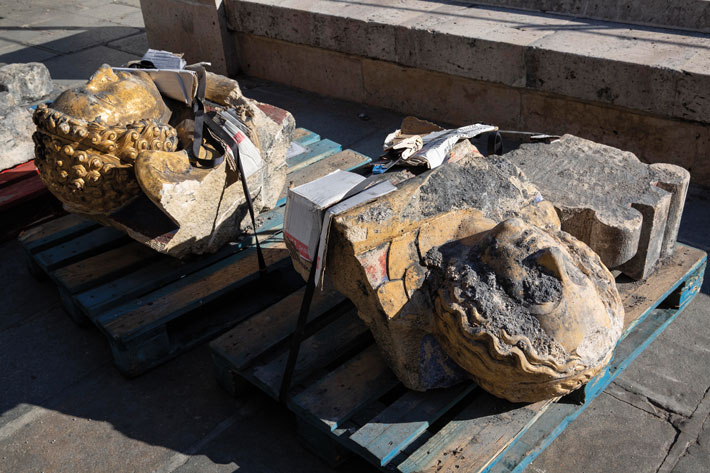
One of the largest groups of researchers is now working on the wood recovered from Notre Dame. These archaeologists and dendrochronologists also had to wait to examine and sample the burned timbers, which were polluted with lead and had to be removed to a dedicated warehouse far north of Paris. The collection of burned medieval timbers is now known as “the forest,” and includes wood from more than 1,000 trees.
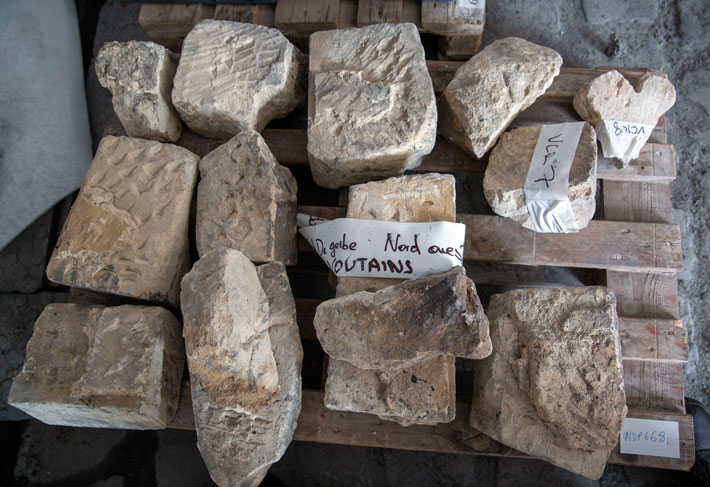
Before the fire it was difficult to obtain permission to take wood samples from Notre Dame, and dendrochronologists had dated just 70 samples. But the fire created an opportunity for more samples to be taken, possibly enabling researchers to answer questions about the chronology of the cathedral’s interior. “We know that the frameworks of the choir and nave are medieval, and that the transept’s framework dates from the nineteenth century,” says Chaoui-Derieux. “It’s now interesting to see whether they underwent several construction phases, and whether wood was replaced in certain sections.”
One of the most daunting challenges of the current work is surveying and documenting the cathedral’s stones, many for the first time. This task falls to a 30-person team led by architectural historian Yves Gallet of Bordeaux Montaigne University. “What made an impression when I first went back to the cathedral after the fire was the direct access to the upper levels and vaults,” says Gallet. “There is a real opportunity for research, as well as to do something to help in the restoration of the monument.”
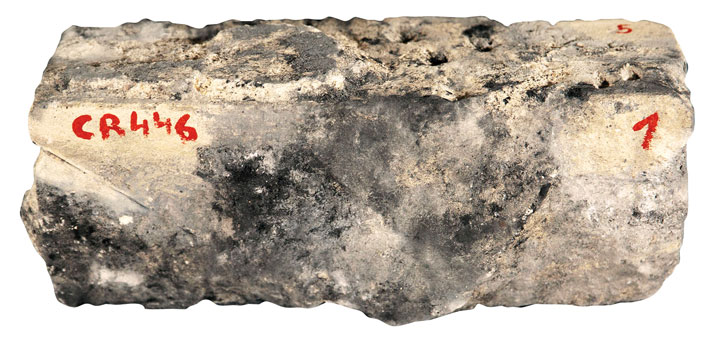
The team’s first objective was to assess what was original and what had been redone later in the north arm of the transept. The south arm was completely remade by Viollet-le-Duc in the nineteenth century, and initial indications from studying the stonework are that the frame of the north rose window was as well. Previously it was believed that the north window is just as it was originally constructed in the thirteenth century. “It was a shock, in a way,” says Gallet, “to realize that here, too, Viollet-le-Duc had to replace all the blocks around the rose.”
Gallet’s group has made additional significant discoveries since the fire. Part of their work is to identify notations left by the stonecutters, either to mark the stones they had cut themselves so they could be paid for their work or to indicate the direction in which a stone was to be laid. Analysis of the voussoirs—wedge-shaped stones used to form arches—recovered from the floor of the nave after the double arch above collapsed has shown that stonemasons carved crosses on one side. This detail has allowed researchers to redate the construction of the vaults. “These crosses were not used in the Île-de-France until after the 1220s,” says Gallet. “This led to a rethinking of the chronology of the site.”

There are also more modern marks. Close examination of the keystone, or central voussoir, in the south arm of the transept revealed the engraved date 1728. The inscription is not visible from below, and no one had ever documented it. “Until now, the scientific literature made no mention of these marks. It’s therefore a novelty, and one which places Notre Dame in a very different perspective,” says Gallet. “This is an unexpected date because art historians have always believed that this keystone dated either from the Gothic period or from the nineteenth-century restorations. We’re still thinking about the best interpretation.”
Perhaps the most extraordinary thing that Gallet’s team has learned thus far is what role medieval craftspeople played in saving Notre Dame during the fire. “What protected the cathedral were its vaults,” Gallet says. “Most of them resisted the fire, which was remarkable, especially as examination of the vaults since then confirms that the ribs are very thin, only around six inches thick, and had to support a 42-foot-wide vault that was 100 feet aboveground.” The only major vault that collapsed did so because it was unable to withstand the sudden weight of the crumbling upper section of the spire. “The vaults played the role of firewall,” says Gallet. “If there had been no stone vaults, the flaming beams of the roof would have fallen to the ground and shattered the stones of the supporting piers. And then the whole cathedral would have collapsed.”
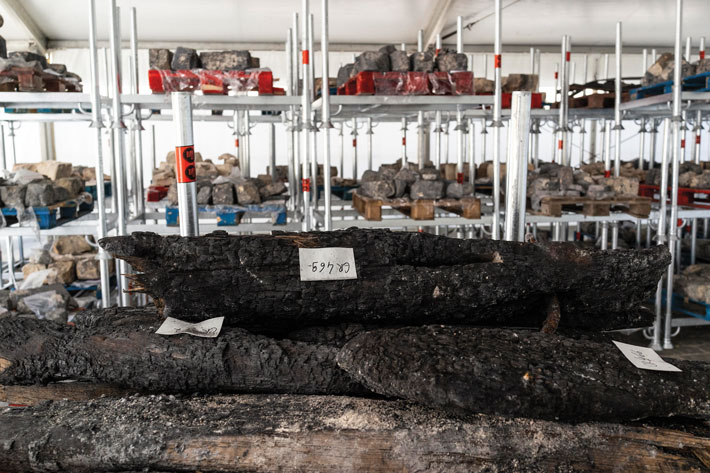
A builders’ crane now hovers over Notre Dame, a stark reminder on the skyline of where the cathedral’s spire once stood. The metal scaffolding erected during the restoration work that was taking place when the fire started melted into and became part of the building. It has now been removed. Apart from continuing work on the thousands of artifacts recovered from the site, there may be other opportunities to learn more about Notre Dame, especially when the work of rebuilding gets fully underway. For example, if the renovation requires excavations to anchor temporary support structures, researchers might be able to study Notre Dame’s original foundations, or perhaps even earlier remnants. (See “Layers of History.") “It’s known that there were iterations of the building before the construction of the Gothic cathedral,” Chaoui-Derieux says. “But few remains of these buildings have been unearthed.”
In the autumn of 2020, INRAP archaeologists carried out a geophysical survey in the cathedral’s basement. A few feet under the paving they detected features they identified as part of the cathedral’s nineteenth- and twentieth-century heating networks. Chaoui-Derieux describes certain other masonry finds as “archaeological anomalies,” and says it’s possible that they could belong to a previous version of the cathedral, or could even be vestiges of Roman structures. Once again, the unique circumstances of the fire enabled this investigation. “It was indeed the first time this was done at Notre Dame, and probably one of the last,” Chaoui-Derieux says. Nevertheless, the possibilities continue. “What intrigued me at Notre Dame when I was a student was those parts of its history that we do not see—the earlier cathedral, the buildings of the early Middle Ages—in short, everything which disappeared with the construction of the Gothic cathedral,” says Gallet. “This is one more step in our treasure hunt.”


